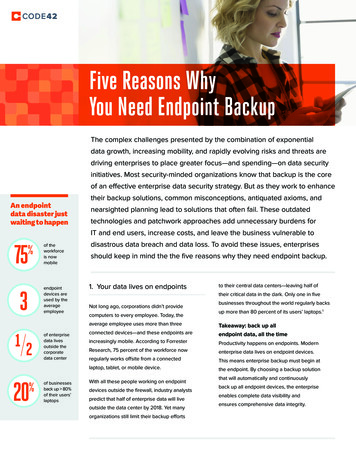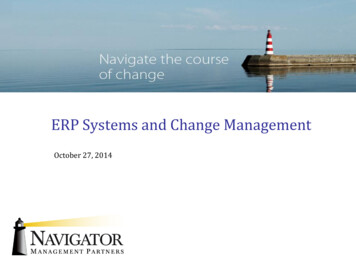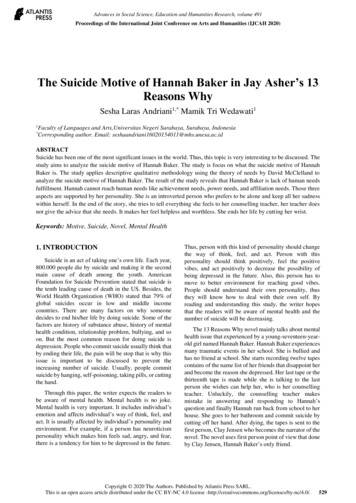
Transcription
Five Reasons WhyYou Need Endpoint BackupThe complex challenges presented by the combination of exponentialdata growth, increasing mobility, and rapidly evolving risks and threats aredriving enterprises to place greater focus—and spending—on data securityinitiatives. Most security-minded organizations know that backup is the coreof an effective enterprise data security strategy. But as they work to enhanceAn endpointdata disaster justwaiting to happentheir backup solutions, common misconceptions, antiquated axioms, andnearsighted planning lead to solutions that often fail. These outdatedtechnologies and patchwork approaches add unnecessary burdens forIT and end users, increase costs, and leave the business vulnerable to75%of theworkforceis nowmobileendpointdevices areused by theaverageemployee3disastrous data breach and data loss. To avoid these issues, enterprisesshould keep in mind the the five reasons why they need endpoint backup.1. Your data lives on endpointstheir critical data in the dark. Only one in fiveNot long ago, corporations didn’t providecomputers to every employee. Today, theaverage employee uses more than three1/220%of enterprisedata livesoutside thecorporatedata centerof businessesback up 80%of their users’laptopsto their central data centers—leaving half ofbusinesses throughout the world regularly backsup more than 80 percent of its users’ laptops.1connected devices—and these endpoints areTakeaway: back up allendpoint data, all the timeincreasingly mobile. According to ForresterProductivity happens on endpoints. ModernResearch, 75 percent of the workforce nowenterprise data lives on endpoint devices.regularly works offsite from a connectedThis means enterprise backup must begin atlaptop, tablet, or mobile device.the endpoint. By choosing a backup solutionWith all these people working on endpointdevices outside the firewall, industry analystspredict that half of enterprise data will liveoutside the data center by 2018. Yet manyorganizations still limit their backup effortsthat will automatically and continuouslyback up all endpoint devices, the enterpriseenables complete data visibility andensures comprehensive data integrity.
FIVE REASONS WHY YOU NEED ENDPOINT BACKUPOutdated backupleaves gaps, adds rnal DrivesAutomatic endpoint backupFragile, easilydamagedCostly upfrontinvestmentEasily lost,stolen or damagedHands-off IT administrationHands-onrestoresPoor scalabilityNo central datavisibility or controlRequires manualconnection andbackupComplete enterprisedata visibilityAgile and scalableCost-effective storage2. Outdated storage mediumscreate challengesaccurate forecast of future storage needs. With enterprise data growing exponentially, this is achallenging and expensive guessing game.Tape-based backupExternal drivesFew people still use a fax machine, yet manyCompanies with large distributed or remoteenterprises have their entire data livelihoodworkforces once provided each employee withprotected by an even older technology:an external drive to back up all their endpointtape-based backup. Like most tape-baseddata. Surprisingly, plenty of organizations stilltechnologies (VHS, audio cassettes, etc.),follow this practice. Much like tape-basedthe tape itself is the greatest failing. Restoresbackup, external drives are vulnerable to physicalare physical, time-intensive tasks. Restorecorruption. And like the laptops they back up,testing is just as clunky—so it’s often avoided.these standalone devices are easily lost orWorst of all, tape is a fragile medium subjectstolen. Beyond these data integrity flaws, externalto heat, light, and physical damage.drives fail to provide enterprise IT with the data visibility they need to address key challengesServer-based backupsuch as breach detection and remediation.Server-based backup will likely always have aappreciate the assurance of having a portionTakeaway: move backup to the cloud tomeet the needs of the modern workforceof their data backed up onsite. This traditionalMost enterprises already leverage a range ofbackup medium by itself can’t keep pace with thecloud-based applications and services, whichrapidly evolving needs of the modern enterprise.enable users to easily access resources,Server-based backup requires remote users tosecurely share data, and drive anytime-anywheremanually connect and backup. Hands-on restoresproductivity. With enterprise data already livingdrain IT resources. And server-based backupin the cloud, it makes sense that enterprisedemands a big upfront investment as well as andata backup would inhabit the same space.role in enterprise data security. Organizations2
FIVE REASONS WHY YOU NEED ENDPOINT BACKUP Simplify endpoint backup Agility for evolving needsCloud-based backup enables reliable and evenCloud backup delivers cost-effective scalability forautomated endpoint backups. No need for VPNthe rapidly growing—and often undulating—dataconnections. No risk of lost or destroyed externalneeds of the modern enterprise. Cloud backupdrives. No worry of endpoint data living in the dark.doesn’t require a major capital expenditure, there are no accompanying procurementEnhance data securityor provisioning headaches, and virtually noBetter endpoint backups drive moreimplementation lag. The enterprise gets thecomprehensive data security, and cloud-basedcapacity it needs now, at minimal cost.backup also makes it easy to collect, protect, andmonitor both structured and unstructured data.3. Human-dependent backupleads to human errorThe latter—including telephone conversations,voicemails, emails, presentations, documents,images, web pages, and videos—accountsTraditional backup—whether tape- or server-for 90 percent of all digital information.based—most often relies on some version of aAlmost one-third of data breaches involvemanual backup process. End users must manuallyunstructured data. Yet only seven percent ofconnect to the central data center and back uporganizations keep track of this form of data.their data—or IT must manually reach out to eachCloud-based backup also provides IT withendpoint device to execute the backup. Evencritical data-loss prevention capabilities,many cloud-based backup solutions still requireincluding geolocation of lost or stolen endpointhands-on end-user or IT-generated backups.devices, and remote wipe capabilities. Two-Enterprise data backup is designed tothirds of companies currently lack the abilityprotect against mistake-prone humans. Soto remotely wipe a lost or stolen device.leaving the essential backup process inhuman hands—or other processes subjectto human error—is a fundamental flaw.90%of enterprise employeesdon’t care about file securityor complianceOn the end user side, studies repeatedly showemployees ignore IT policies, such as thoserequiring regular manual data backups. Why?Because almost 90 percent of enterpriseemployees say they simply don’t worry about file security or compliance—that’s IT’s job. ToCheaper to store—cheaper to restoreend users, backup is just a high-friction choreFrom global enterprises to regional companies,that depletes productivity. They ignore it orcloud backup can significantly reduce the costwork around it, leaving data unprotected.of maintaining storage space. It also dramaticallyreduces the IT cost of time-consuming manualPushing the task to IT doesn’t typically deliverrecovery. With IT freed from tedious restores,better results. Manual backups eat up high-enterprises can redirect these resources todemand IT resources and increase costs. And ITother productivity-boosting tech initiatives.professionals aren’t robots—they’re human, they3
FIVE REASONS WHY YOU NEED ENDPOINT BACKUPmake mistakes, and these backup errors can allowSupporting the Macempowered enterprisecritical enterprise data to fall through the cracks.Takeaway: deploy continuous,automatic endpoint backup90of companies now supportMac devices for at least someportion of their workforce95of business that don't supportMacs would do so if PC andMacs shared a single, centralmanagement system%A modern backup solution can’t be dependenton human action or compliance with policies.To mitigate the many human-factor risks, theenterprise needs a backup solution that deliversautomatic, continuous, and inconspicuous%endpoint backup. This functionality runssilently in the background with no impact onend user productivity, and eliminates the costand burden of IT-executed manual backups.they need much more than Apple’s Time Machine4. Piecemeal solutionslead to security gapsto back up Mac devices. But legacy backupsolutions like HP Connected and Commvaultwere designed specifically for Windows-basedPCs. As mentioned, retrofitted solutions areAs enterprises scramble to catch up withinexact, inelegant, and leave too much room forevolving technologies, it’s tempting todata loss. Many organizations deploy two backuptake a piecemeal approach—pluggingsolutions—one for Windows and one for Mac.small gaps with specific patches. This leaves IT managing multiple systems—abig headache with bigger costs. In fact, oneRetrofitting legacy backup solutionssurvey found that 95 percent of businesses thatNot surprisingly, many server-based backupdo not currently support Macs would seriouslyvendors have attempted to retrofit their solutionsconsider doing so—if they had a single, centralto meet the needs of a mobile, cloud-proficientmanagement system for both PCs and Macs.3workforce. But too often, patchwork systemsmanual tasks and complex administration toTakeaway: secure and manage allendpoints from a single point of controlmake up for innate shortcomings. Moreover,A comprehensive enterprise data securitythe core of these systems—static, sluggishstrategy requires a comprehensive solution—notserver-based backup—can’t provide sufficienta piecemeal or patchwork approach. Platform-agility and scalability to adapt quickly toagnostic, cloud-based endpoint backup solutionsevolving needs. Retrofitted solutions are in aare built for the diverse technology environmentconstant state of (dis)repair, with continual ITof the modern enterprise, providing a seamlessheadaches and far too much risk for data loss.backup and restore experience regardless of solutions enable the enterprise to ensure theonly shift greater workload onto IT staff, requiringdevice or operating system. These completePlatform-specific productsToday, more than 90 percent of companiesintegrity of all endpoint data, and give IT asupport Mac devices as part of a hybridsingle, simplified platform for monitoring andenvironment. These organizations quickly realizemanaging all users, all endpoints and all data.24
FIVE REASONS WHY YOU NEED ENDPOINT BACKUP5. It’s more than file restorecapabilities to reduce IT burden and drivecost savings—all while dramatically reducingthe risk of data loss. Endpoint backup alsoRestoring lost data due to technology failure,streamlines the costly and complicated legaluser error, or theft is the most basic functionof enterprise backup solutions. Many legacyhold process, providing guaranteed data integrityproducts built their software architecture,and remote data management capabilitiesworkflows, and functionality around this oneto dramatically reduce eDiscovery costs.feature alone. But today, top-tier enterprisebackup solutions focus instead on complete datavisibility. This core feature enables guaranteed, Backup that moves the business forwardForward-thinking enterprises and IT professionalsefficient backup and restores in the event ofalready know they need to renew their focus onendpoint data disaster. But it also enablesendpoint backup to solve the critical challengesthese solutions to go well beyond backup.and mitigate pertinent risks of the modernenterprise. Patching up legacy, server-basedTakeaway: leverage endpoint backup tosolve prominent IT and business challengessolutions or piecing together products with limitedThe savvy enterprise now leverages completeonly add to the burden on IT staff—and leavedata visibility to deliver risk reduction across thevulnerable gaps in a data security strategy. Toenterprise and address perennial IT and businessmeet the needs of the modern enterprise, anproblems. In the event of data breach or data theft,the best endpoint backup solutions do more thanguarantee file recovery; they provide the forensicevidence that helps InfoSec professionals identifyabnormalities faster, isolate and limit data loss, andmitigate the cost and impacts of these events.capabilities won’t cut it. These approaches willeffective backup solution must deliver automatic,continuous, cloud-based backup of all endpointdata. But it must do far more than ensure thatlost or damaged data can be restored – it mustmitigate the risk of data loss and data breach,streamline IT workloads, leverage the costComplete data visibility helps solve challengesefficiencies and scalability of the cloud, andoutside of traditional data security. IT canempower anytime-anywhere user productivity.accelerate and simplify tech refresh and dataWith the right solution in place, the enterprise canmigration, managing user migrations from atransform these benefits into critical competitivesingle platform and deploying self-serviceadvantages that drive the business forward.Reference links:12016 Cyberthreat Defense Report2JAMF 2015 Survey: Managing Apple Devices in the Enterprise3ParallelsCONTACT CODE42 SALES:code42.com/contactCORPORATE HEADQUARTERS 100 WASHINGTON AVENUE SOUTH MINNEAPOLIS, MN 55401 612.333.4242 CODE42.COMCode42, the leader in cloud-based endpoint data security and recovery, protects more than 39,000 organizations worldwide. Code42 enables IT and security teamsto centrally manage and protect critical data for some of the most recognized brands in business and education. From monitoring endpoint data movement and use, tomeeting data privacy regulations, to simply and rapidly recovering from data incidents no matter the cause, Code42 is central to any organization’s data security strategy.Code42 is headquartered in Minneapolis, MN and backed by Accel Partners, JMI Equity, NEA and Split Rock Partners. For more information, visit code42.com.FEBRUARY 2017 / WP021717
This means enterprise backup must begin at the endpoint. By choosing a backup solution that will automatically and continuously back up all endpoint devices, the enterprise . should keep in mind the the five reasons why they need endpoint backup. An endpoint data disaster just waiting to happen 75% of the workforce is now mobile 3 endpoint .










